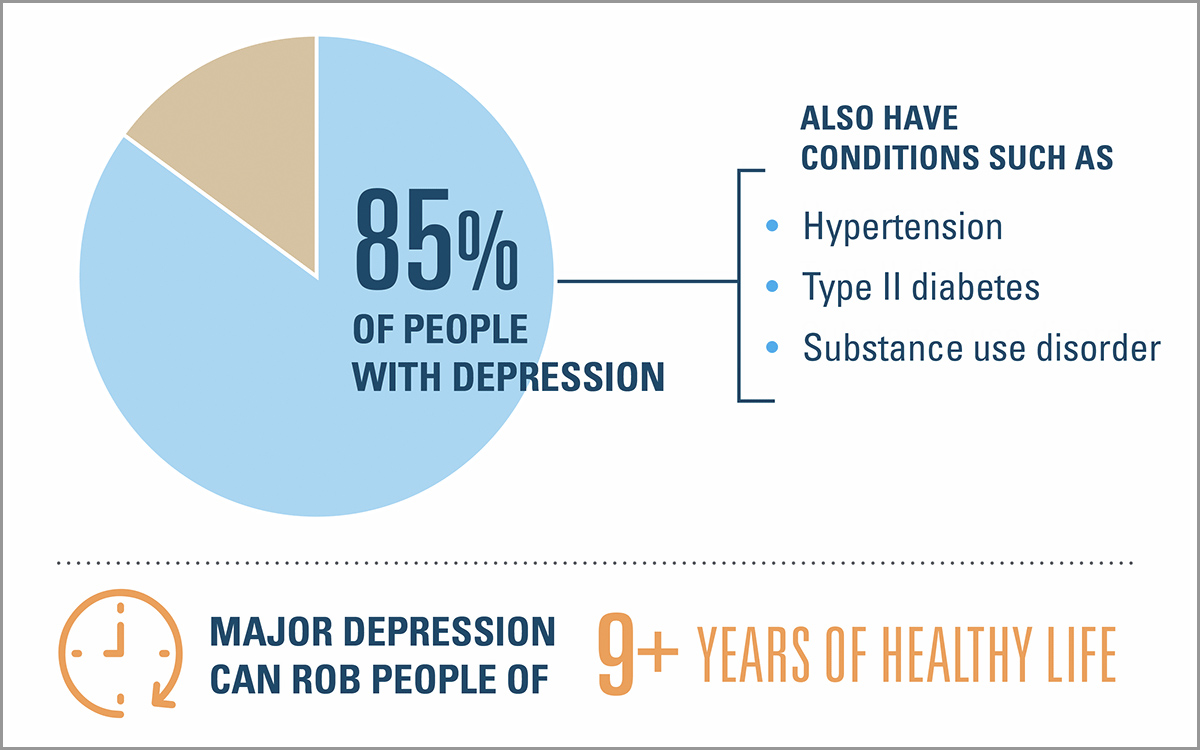
The Therapist Is In 24/7: How Virtual Care Offers Workplace Solutions for Behavioral and Mental Health
November 2019
Vincent Nelson, M.D., Vice President, Medical Affairs, Blue Cross Blue Shield Association
Today’s workforce faces a range of mental and behavioral health issues, including stress, anxiety, depression and substance use disorder. Millennials, soon to be the largest segment in the workplace, are especially at risk. For them, major depression rose by 31 percent from 2014 to 2017, becoming more prevalent than hyperactivity and type 2 diabetes.1
Employers have a vested interest in getting employees of all ages the help they need and are beginning to add or expand mental health and behavioral solutions.
Mental health issues reduce employee productivity and cost employers money
The cost of direct mental health treatment, at $26 billion, might seem like a lot of money. But that amount is nowhere near what employers pay for mental health-related absenteeism, estimated at $51 billion.2 And you can’t ignore the impact mental or behavioral health conditions have on overall health and wellbeing, which directly affect how able and engaged employees are at work.
Most Americans with major depression also have one or more serious chronic health conditions

The need for mental health support spurs innovative solutions
Nearly six in 10 Americans are seeking or wanting to seek mental health services either for themselves or for a loved one, yet nearly half have to drive more than an hour round trip for treatment.3 Innovative solutions, many of which leverage technology, are catching up with the growing demand for access to mental health care. Below are key areas to watch.
Telehealth. A majority of employers already offer telebehavioral health services, allowing employees to speak with an emotional health coach right away. Telehealth is ideal for millennials because they’re much more likely to use technology to interact with the healthcare system in general.4 Employees who live in “mental health deserts” or are uncomfortable walking into a therapist’s office can also benefit from an online or virtual visit with a mental health provider.
For example, LiveHealth® Online is a telehealth app first launched by Anthem Blue Cross and Blue Shield (Anthem BCBS) in Missouri four years ago, providing members with the option to have a video call with a licensed therapist in the privacy of their home or car. Because of its success in Missouri, LiveHealth is now available to Anthem BCBS members across the country.
Aneesh Kuma, Anthem BCBS's Vice President of Commercial Products says, "We fundamentally believe that digital access will drive down the cost of care to help make mental healthcare more affordable and more accessible for everyone." 5
In today’s global economy, it’s not uncommon for employees to travel and work overseas. The stress of being away from home can cause or worsen anxiety and even depression. Navigating another country’s healthcare system can further exacerbate these conditions. GeoBlue® offers telehealth solutions for both physical and mental health needs, providing members with confidential access to counselors and wellness coaches around the world. Taking a holistic approach to care, GeoBlue also helps minimize stress by providing referrals to local resources such as legal counsel or childcare providers. In 2020, GeoBlue will launch its Global TeleMD app, making secure phone or video calls with doctors even easier, anywhere in the world.
Online Tools. Since most employees are living very busy professional and personal lives, it can be a real challenge to seek and obtain mental health treatment when it's needed. Also, given the stigma that still exists around mental health, some opt to manage these challenges on their own. To address the need for more convenient and private ways for employees to manage their emotional health, employers are looking to online mental health tools and resources.
For example, Independence Blue Cross offers a free, confidential online program designed to help its members improve their emotional well-being with self-assessments, articles, videos, and personalized and guided therapy available anytime, 24/7. Members can quickly assess their emotional well-being through the program's mental health screener and then receive a personalized list of available online programs and resources, including evidence-based cognitive behavioral therapy. Through these digital tools, members can better manage their day in real-time by learning and practicing skills to overcome common challenges such as anxiety, depression and alcohol or substance use disorder.
Wearables. As more companies and start-ups enter the wearables space, we’ll likely see the function of them evolve from tools to track activity, heart rate or sleep to more personal, two-way interactions. For example, a care provider could assist an employee in managing depression, substance use disorder or other health issues through a wearable device.
AI. Amazon’s new HIPAA-compliant Alexa allows additional types of information, such as patient health records, to be securely transmitted. Most of the emerging HIPAA-compliant innovations are around physical health, such as recognizing cardiac arrest during 911 emergency calls.6 But it’s easy to see how receiving behavioral health information via Alexa has the potential to help employees manage stress and other conditions.
Reducing hospital admissions with a person-centered tool for panic attacks
When a person is having a panic attack, they often think they’re having a heart attack and rush to the emergency department. Compared to healthy peers, people experiencing a panic attack visit the ED five times more often and have a 26 percent higher incidence of substance use disorder.7
Those with panic attacks tend to hyperventilate, which exacerbates the condition. Highmark Blue Cross and Blue Shield in Pittsburgh, Pennsylvania, worked with their innovation lab VITAL and the developers of a third-party digital tool that teaches panic-prone patients to stabilize their breathing. The tool requires that the patient commit to 17-minute sessions twice a day, so designers made sure they created an experience that would keep the patient engaged and therefore more likely to adhere to the program. After four weeks, 71 percent of patients experienced zero panic attacks. Even better, 79 percent of patients remained panic attack-free after 12 months.
Making behavioral and mental health innovations work for your organization
When adopting innovations to help your employees manage stress or mental health conditions, here are a few tips to keep in mind:
- 1) Take mental health seriously. Consider it to be just as important as other medical conditions.
- 2) Help remove the stigma of getting help by educating your employees and being open about mental health conditions. If your company offers telebehavioral solutions, promote it in company newsletters, text messages, emails and on your intranet. Senior executives could consider including a message on how to contact mental health services in their internal email signature.
- 3) Promote better mental health in your work environment. Consider healthy food and drink options, free exercise classes, meditation or stress reduction training, and if possible, flexible work hours.
© 2019 Blue Cross Blue Shield Association. All Rights Reserved. The Blue Cross Blue Shield Association is an association of independent, locally operated Blue Cross and Blue Shield companies. All third party trademarks and trade names are used for informational purposes only and are the property of their respective owners.
1 Blue Cross and Blue Shield, The Health of America, “The Health of Millennials,” April 24, 2019.
2 Mental Health of America, “Depression in the Workplace,” 2019, https://www.mhanational.org/depression-workplace, accessed October 15, 2019.
3 National Council for Behavioral Health, “New Study Reveals Lack of Access as Root Cause for Mental Health Crisis in America,” October 10, 2018, https://www.thenationalcouncil.org/press-releases/new-study-reveals-lack-of-access-as-root-cause-for-mental-health-crisis-in-america/.
4 Blue Cross Blue Shield Association, National Generation Survey, 2019.
5 Blue Cross Blue Shield Association, "Addressing behavioral health access with telemental health solutions", October 24, 2019, https://www.bcbs.com/the-health-of-america/articles/addressing-behavioral-health-access-telemental-health-solutions.
6 HIPAA Journal, “Amazon Announces 6 New HIPAA Compliant Alexa Skills,” April 5, 2019, https://www.hipaajournal.com/hipaa-compliant-alexa-skills/.
7 Freespira, “Multiple Studies Show Freespira® Eliminates Panic Attacks in 80% of Patients,” April 11, 2018, https://freespira.com/multiple-studies-show-freespira-eliminates-panic-attacks-in-80-of-patients/.

 Vincent Nelson, M.D., is vice president of Medical Affairs in the Office of Clinical Affairs (OCA) for the Blue Cross Blue Shield Association (BCBSA), a national federation of 36 independent, community-based and locally operated Blue Cross and Blue Shield (BCBS) companies. Today, one-in-three Americans are covered by the BCBS system.
Vincent Nelson, M.D., is vice president of Medical Affairs in the Office of Clinical Affairs (OCA) for the Blue Cross Blue Shield Association (BCBSA), a national federation of 36 independent, community-based and locally operated Blue Cross and Blue Shield (BCBS) companies. Today, one-in-three Americans are covered by the BCBS system.
